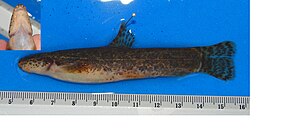Barbatula quignardi
| Barbatula quignardi | ||||||||||||
|---|---|---|---|---|---|---|---|---|---|---|---|---|

Barbatula quignardi |
||||||||||||
| Systematics | ||||||||||||
|
||||||||||||
| Scientific name | ||||||||||||
| Barbatula quignardi | ||||||||||||
| ( Băcescu-Meşter , 1967) |
Barbatula quignardi is a benthic freshwater fish species of the genus Barbatula from the family of loach (Nemacheilidae). The species was described in 1967 and occurs in southwestern France and northeastern Spain .
features
Like all representatives of the genus Barbatula , the animals have an elongated, slender body with a gray-yellow basic color and irregular spots along the body flanks. The animals have a lower mouth, which is surrounded by 6 barbels . Barbatula quignardi has a slightly bulged caudal fin . The dorsal fin begins at about the same level as or just before the attachment of the pectoral fin . The tail stalk is 1.1-1.6 (in most cases 1.3-1.4) times as long as it is wide. There are 2–4 irregular dark spots between the neck and the base of the dorsal fin. The species reaches a standard length of up to 7 cm.
Ecology and diffusion
The animals live on the ground and use their barbels to track down invertebrates that serve them as food. They live in river sections with sandy or stony substrate.
The distribution area is in southwest France and northeast Spain. In France, the species was found in the catchment areas of the Lez and Tech , which flow into the Mediterranean, and in the Adour and Garonne river systems , which drain into the Atlantic Ocean. In Spain the species occurs naturally in the Ebro system and was introduced into the Douro system.
Barbatula quignardi is classified by the IUCN as " Least Concern " ( LC ).
swell
- ↑ Barbatula quignardi summary page. Retrieved February 24, 2019 .
- ↑ Maurice Kottelat, Jörg Freyhof: Handbook of European Freshwater Fishes . Kottelat, Cornol, Berlin 2007.
- ^ The IUCN Red List of Threatened Species. Retrieved February 24, 2019 .
